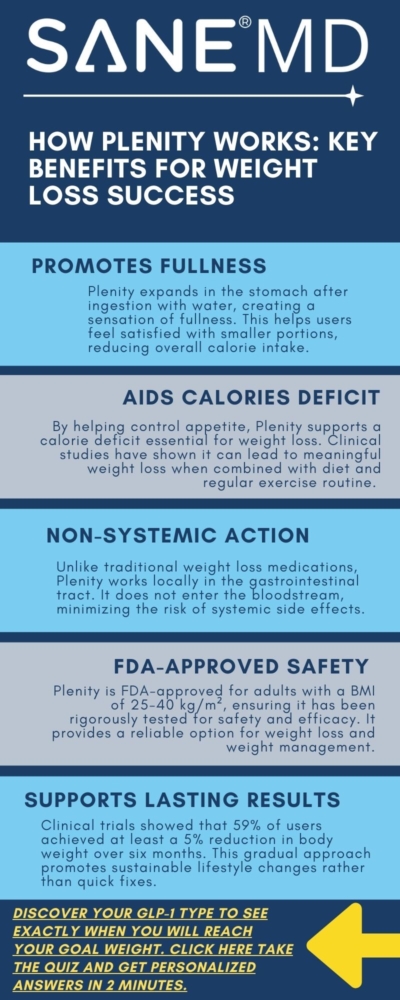Could Plenity Help You Reach Your Weight Loss Goals? Take the Quiz!
Dr. Matthew Olesiak, MD, is the Chief Medical Director at SANESolution, a renowned wellness technology company dedicated to providing evidence-based solutions for optimal living. Dr. Olesiak earned his medical degree from the prestigious Jagiellonian University Medical College in Kraków, Poland, where he developed a strong foundation in medicine.
Plenity is a unique medical device designed for individuals struggling with excess weight, offering a non-systemic approach to weight management. Designed for overweight and obese adults, plenity works by promoting fullness and satiety, helping users reduce their food intake and achieve a calorie deficit essential for weight loss. Unlike traditional medications, it functions locally in the gastrointestinal tract with minimal side effects. So, could Plenity help you reach your weight loss goals?
If you’re exploring whether Plenity aligns with your weight loss needs, consider taking the weight loss drug type quiz to gain personalized insights into its potential fit for your goals.
Key Takeaways
Before diving into the details, here are four key points to know about Plenity:
- Plenity promotes satiety by expanding in the stomach, helping reduce calorie intake.
- It is FDA-approved for weight management in adults with a BMI of 25-40 kg/m².
- Plenity works locally in the gastrointestinal tract, offering a non-systemic approach with minimal side effects.
- Plenity can help achieve clinically meaningful weight loss, defined as a 5% or more reduction in body weight.
What is Plenity?
Plenity is an oral capsule that aids in weight management by promoting a feeling of fullness. Unlike traditional weight loss medications, which can often have systemic side effects, Plenity is classified as a medical device. It is made from naturally derived hydrogel particles composed of cellulose and citric acid. Plenity’s unique mechanism of action involves expanding in the stomach to promote satiety without being absorbed into the bloodstream, making it a safer alternative. For a comparison of non-systemic and systemic weight loss aids, see our guide on Plenity vs Ozempic for weight loss.
Designed specifically for overweight and obese adults, these hydrogel capsules for weight loss help users control their appetite and reduce overall calorie consumption. By encouraging satiety, it serves as a helpful tool in combination with diet and exercise for sustainable weight management.
How Plenity Works
Plenity operates through a straightforward yet effective mechanism. After ingestion with water, its hydrogel particles expand in the stomach, increasing the volume of contents. This expansion creates a sensation of fullness, helping individuals feel satisfied with smaller meals. Plenity’s efficacy was validated in a randomized, double-blind, placebo-controlled study.
The hydrogel particles mix with food in the stomach and small intestine, enhancing the elasticity and viscosity of the contents. This slows digestion and prolongs the feeling of satiety. Importantly, Plenity is non-systemic, meaning it works only within the gastrointestinal tract and does not enter the bloodstream, minimizing potential side effects.
Benefits of Plenity for Weight Management
The benefits of Plenity extend beyond simply reducing appetite.
Here’s an overview of its advantages:
- Promotes Satiety: By creating a feeling of fullness, Plenity helps manage appetite, reducing the likelihood of overeating.
- Gradual Weight Loss: Clinical trials have shown that combining Plenity with a balanced diet and exercise helps individuals lose weight effectively.
- FDA Approval: As an FDA-approved medical device, Plenity has undergone rigorous testing to ensure safety and efficacy.
These benefits make Plenity a valuable option for certain individuals looking to manage their weight sustainably. Read our guide for more about Plenity’s metabolic health benefits.
Clinical Evidence and Results for Clinically Meaningful Weight Loss
Clinical trials have provided promising results about Plenity’s effectiveness. Participants who used Plenity for weight management experienced a mean average weight loss of 6.4%, compared to 4.4% in those using a placebo. Participants in the clinical trials were instructed to follow a prescribed reduced caloric intake and engage in exercise.
Additionally, 59% of Plenity users achieved at least a 5% reduction in body weight, compared to 42% of placebo users. A smaller subset, 27%, lost 10% or more of their body weight, highlighting the potential for significant results in some individuals. Early responders to Plenity therapy were more likely to achieve meaningful weight loss by the 24-week mark, reinforcing its role as an effective weight management tool.
Safety and Tolerability
While Plenity is generally well-tolerated, it is not suitable for everyone. Individuals with hypersensitivity to its components, prior gastrointestinal surgeries, or a history of strictures should avoid its use. Additionally, Plenity should not be prescribed to pregnant individuals due to safety concerns.
Its non-systemic nature minimizes the risk of severe side effects. However, taking Plenity with other medications may interfere with absorption, so careful timing and consultation with a healthcare provider are essential. Clinical trials showed no serious adverse events in the treatment group, highlighting Plenity’s safety profile.
Usage and Administration
Using Plenity correctly is vital for optimal results. The recommended dosage is three capsules taken with water 20-30 minutes before lunch and dinner. This timing allows the hydrogel particles to expand in the stomach before meals, promoting a feeling of fullness.
Patients should carefully follow the instructions provided by their healthcare provider or included with the product. To avoid interference with medication absorption, Plenity should be taken as directed and not simultaneously with other treatments.
Important Considerations
Plenity is intended for adults with a Body Mass Index (BMI) of 25-40 kg/m², regardless of whether they have weight-related health conditions. While it can effectively aid weight management, it is not a standalone solution.
For the best results, Plenity should be used alongside lifestyle changes, including a reduced-calorie diet and regular exercise. Always consult with a healthcare provider before beginning Plenity to ensure it suits your personal health requirements and weight loss objectives.
Side Effects and Contraindications Including Abdominal Pain
The most common Plenity side effects are gastrointestinal in nature, such as bloating, flatulence, abdominal discomfort, and abdominal pain. These symptoms are generally mild and subside as the body adjusts to the treatment.
Plenity is contraindicated in individuals with severe allergic reactions to its components or those who have had prior gastrointestinal surgeries. Consulting a healthcare provider is crucial to evaluate whether Plenity is suitable for you.
Contraindications and Interactions
Plenity is contraindicated in certain individuals, including those with a history of severe allergic reactions to cellulose or citric acid. Additionally, Plenity may not be suitable for individuals with specific medical conditions, such as:
- Esophageal anatomic anomalies
- Complications from prior gastrointestinal surgery
- Active gastroesophageal reflux disease (GERD)
- Peptic ulcer disease
- Heartburn
It is essential to consult with a healthcare provider before taking Plenity, especially if you have any underlying medical conditions or are taking medications that may interact with Plenity. Plenity may interact with certain medications, such as:
- Blood thinners
- Diabetes medications
- Medications for high blood pressure
- Medications for high cholesterol
Discussing your medical history and current medications with your healthcare provider will help ensure that Plenity is a safe and effective option for you.
Realistic Expectations
While Plenity can be a valuable tool for weight management, it is essential to have realistic expectations. Plenity is not a magic pill, and it should be used in conjunction with a healthy diet and regular exercise. On average, participants in clinical trials lost around 6% of their body weight over six months. However, individual results may vary, and it is crucial to focus on sustainable lifestyle changes rather than relying solely on Plenity for weight loss.
Factors that may influence the effectiveness of Plenity include:
- Starting body mass index (BMI)
- Level of physical activity
- Dietary habits
- Overall health status
By setting realistic goals and combining Plenity with a balanced diet and regular exercise, you can potentially achieve meaningful and sustainable weight loss.
Patient Information and Support
For effective use, patients should take three Plenity capsules with water 20-30 minutes before lunch and dinner. Each dose is provided in a single blister pack, ensuring easy tracking and compliance.
Patients are encouraged to adhere to the instructions provided and consult their healthcare providers for guidance and support. Combining Plenity with a structured weight loss plan can maximize its benefits and promote long-term success.
FAQs About Plenity
Many individuals have questions about Plenity and how it works.
Below are answers to some of the most frequently asked questions to provide clarity and help you make informed decisions about this weight management tool.
1. What is Plenity, and how does it work?
Plenity is a medical device composed of hydrogel particles that expand in the stomach to promote a feeling of fullness. After ingestion with water, the particles mix with food to increase the stomach’s volume, reducing hunger and helping control calorie intake. It works locally in the gastrointestinal tract without systemic absorption.
2. Who is eligible to use Plenity?
Plenity is FDA-approved for adults with a BMI of 25-40 kg/m². However, it is not suitable for individuals with hypersensitivity to its components, gastrointestinal strictures, or those who are pregnant. A healthcare provider can determine if Plenity is right for your specific needs.
3. Are there any side effects associated with Plenity?
Common side effects of Plenity include bloating, flatulence, and abdominal discomfort, which are typically mild and temporary. Serious side effects are rare, but individuals with underlying conditions should discuss potential risks with their healthcare provider.
4. How is Plenity different from other weight loss treatments?
Unlike medications, Plenity is a medical device that works locally in the stomach, not systemically. This non-systemic approach reduces the risk of widespread side effects and makes it a unique option among weight management options.
5. Can Plenity be used with other weight loss strategies?
Plenity works best when combined with a reduced-calorie diet and regular exercise. Patients should consult their healthcare provider before integrating Plenity with other treatments to ensure safety and compatibility.
Conclusion
Plenity offers a non-systemic, FDA-approved option for weight management in overweight and obese adults. By promoting fullness and satiety, it helps users control their calorie intake and achieve gradual, sustainable weight loss when combined with healthy lifestyle changes.
If you’re considering Plenity, consult your healthcare provider and take the weight loss drug type quiz here to determine if it aligns with your weight loss goals. By making informed decisions, you can take the first step toward achieving a healthier future.





